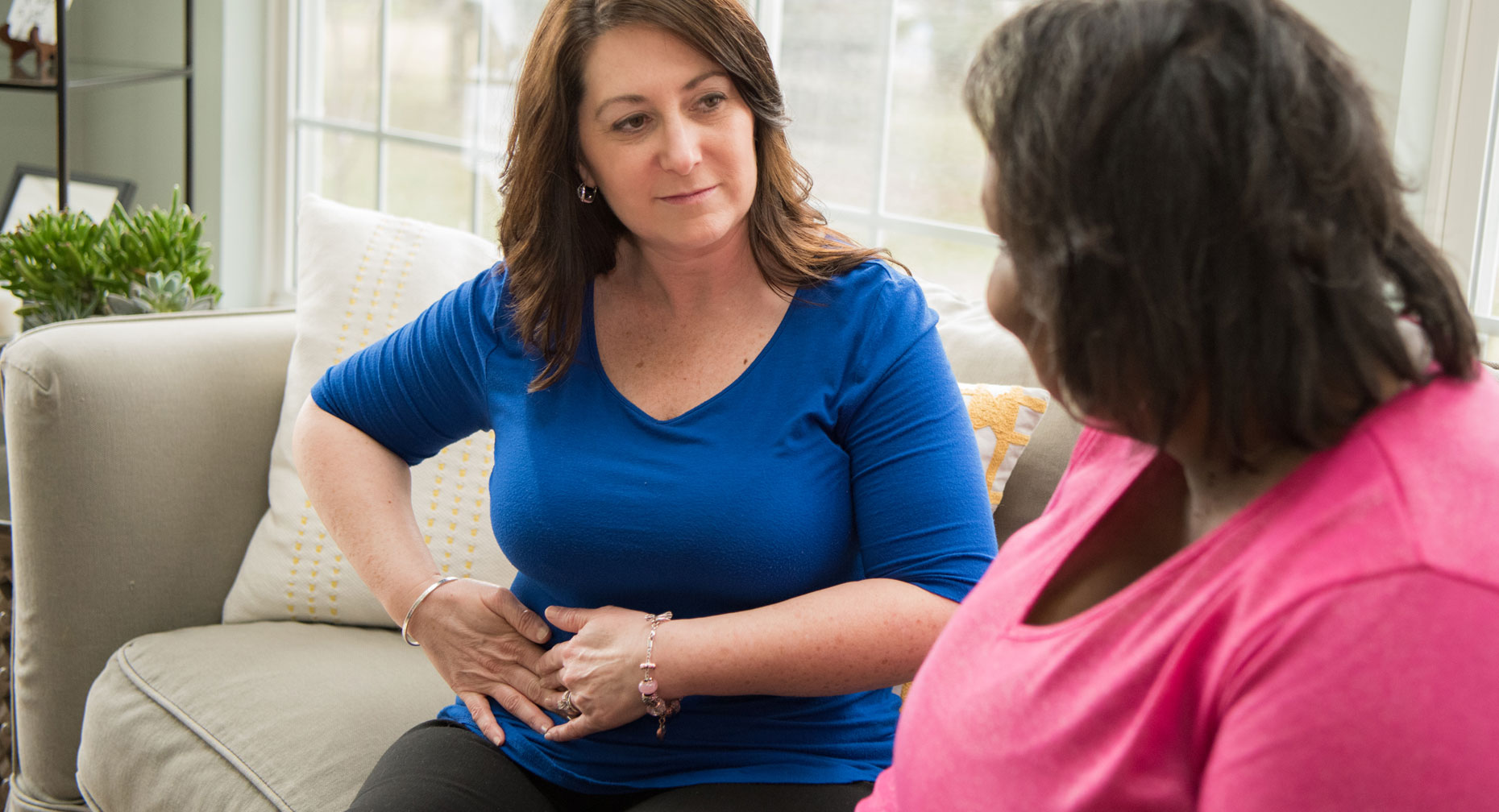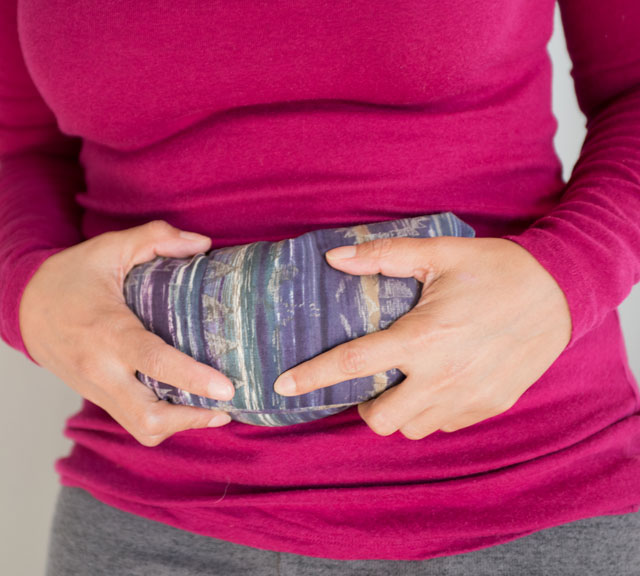Pelvic Pain? Check These 4 Causes

Find Your Perfect Match
Answer a few questions and we'll provide you with a list of primary care providers that best fit your needs.
Endometriosis, uterine fibroids, ovarian cysts, and hernias are four common conditions that can all cause pain in the lower abdomen.
But while all four share pelvic pain as a symptom, the conditions themselves are quite different, and the onset and intensity of pain varies.
“Fibroid pain is more gradual in nature, and more associated with bleeding and pressure,” explains Heather Hilkowitz, MD. “Endometriosis pain comes with the menstrual cycle and sex. Pain from ovarian cysts tends to be more acute, the ‘wake you in the middle of the night’ kind of pain.”
If you experience pelvic pain, learning more about the different causes can help you know what’s normal and what isn’t, and when to seek medical help. Here's an overview of the four conditions and how they differ:
1. Ovarian Cysts
When a woman is ovulating, Dr. Hilkowitz explains, a tiny fluid-filled sac called a follicle forms in the ovary, and an egg grows within that sac. When the egg matures, the follicle releases it. But if the egg doesn’t release, the sac begins to grow. These growths are called follicular cysts.
Another type of ovarian cyst is a corpus luteum cyst, which occurs after an egg is released. These occur if the sac doesn’t shrink. Instead, it re-seals, and fluid builds up inside. These sometimes bleed and can “twist” the ovary and cause severe pain (known as “torsion”).
“Basically, something has gone awry to cause the cyst to start growing on its own,” she says.
In many cases, women aren’t even aware that they have cysts. They are often harmless and go away with time. “Generally, the first step in treating ovarian cysts is to simply monitor them,” says Dr. Hilkowitz. “That’s because 80 percent will go away with no treatment.”
Some ovarian cysts are referred to as “complex.” “These include cysts that fill with blood and/or a material other than fluid, have become a benign or cancerous tumor, or are a result of endometrial tissue growing (see below) on the ovaries,” explains Dr. Hilkowitz.
Ovarian cysts are less common after menopause. While most postmenopausal cysts are not worrisome, they can put you at higher risk for ovarian cancer. “As a result, you should be closely followed and evaluated by your physician,” Dr. Hilkowitz advises.
When symptoms do occur, they may include:
- Pelvic pressure or pain, dull or sharp
- Bloating or swelling in the abdomen
- Needing to urinate more often
- Abnormal vaginal bleeding
- Pain during intercourse
- Pain during bowel movements
It’s important to contact your doctor if you are experiencing any of these symptoms, but especially if you experience sudden and severe pelvic pain that may or may not be accompanied with nausea or vomiting. This may be a sign of torsion (twisting of the ovary by the cyst growth), the cyst affecting the ovary’s blood supply, and/or rupture of a cyst with internal bleeding.
2. Uterine Fibroids
Dr. Hilkowitz describes the uterus (the womb) as “one big muscle.” Uterine fibroids, she explains, are basically muscle tumors — parts of the muscle that simply start to grow on their own. Estrogen “feeds” the fibroids and causes them to grow.
“They are exceedingly common,” says Dr. Hilkowitz, “and don’t usually cause problems.”
Fibroids are usually slow-growing, almost always benign, and vary widely in size and frequency. Women may have a single fibroid, or multiples. The fibroids can be as small as a seed or as big as a softball. In rare cases, they can become very large. They occur most frequently in women in their 40s and early 50s.
When fibroids do become noticeable, they can be difficult to live with. Symptoms include:
- Heavy and/or painful periods
- Pain during sex
- Lower back pain
- Bladder pressure, causing frequent urination
- Rectal pressure
- A distended (enlarged) abdomen, sometimes making a woman look pregnant
“Generally, the first step in treating ovarian cysts is to simply monitor them,” says Dr. Hilkowitz. “That’s because 80 percent will go away with no treatment.”
If the pain from fibroids is dull and/or mildly cramping, Dr. Hilkowitz recommends that you ease your discomfort with over-the-counter treatments, including heat therapy, warm baths, and over-the-counter medications like ibuprofen (Advil or Motrin) or naproxen (Aleve).
If the pain continues, or becomes sudden and sharp, “it deserves a call in to your doctor’s office,” she says. “The staff can help determine if you need to be seen right away.”
3. Endometriosis
“ Endometriosis occurs when the same tissue that lines your uterus prior to your period grows on the outside of the uterus, on ligaments that support the uterus, and on other structures within the pelvis,” explains Dr. Hilkowitz.
And just like the tissue inside your uterus, this tissue responds to the estrogen that the ovaries produce, which means the tissue can bleed. “This causes inflammation, which over time causes scar tissue,” explains Dr. Hilkowitz.
This, of course, can be very painful, especially during menstruation, during intercourse, and sometimes during bowel movements. In fact, pain is the main symptom of endometriosis, although some women may experience no pain at all.
Hernia
A hernia happens when part of an internal organ or tissue bulges through a weak area of your muscle. Most are located in your abdominal area and can result from muscle weakness and straining from lifting heavy objects. They can be difficult to diagnose, says surgeon James de Caestecker, DO.
Physicians may often attribute the pain to other causes and not consider a hernia, he adds. “Some women have pain for years and it has progressed to a point where it affects their lifestyle. I put a scope into many of these women, find a hernia, fix it, and they are extremely happy. The pain is gone and their quality of life has improved.”
See Your Doctor
There are treatments for pelvic pain, so it’s important that you see your doctor if you have any concerns. You also will want to make sure that you get a proper diagnosis, so don’t ignore pelvic pain.
When you visit your doctor for pelvic pain, you will have a physical exam, including a pelvic exam. Tests also may be done to find the cause.
It also may be necessary to see other specialists to find out the cause of your pain, such as a gastroenterologist (a physician who focuses on digestive problems) or urogynecologist (a gynecologist specializing in urinary and related problems).
Find Your Perfect Match
Answer a few questions and we'll provide you with a list of primary care providers that best fit your needs.
Source: National Institutes of Health; Office of Women’s Health, U.S. Department of Health and Human Services; American College of Obstetrics and Gynecology; OBGYN.net; Heather Hilkowitz, MD, Hilltop Obstetrics & Gynecology; James de Caestecker, DO, Gem City Surgeons

Heather L. Hilkowitz, MD
View Profile




